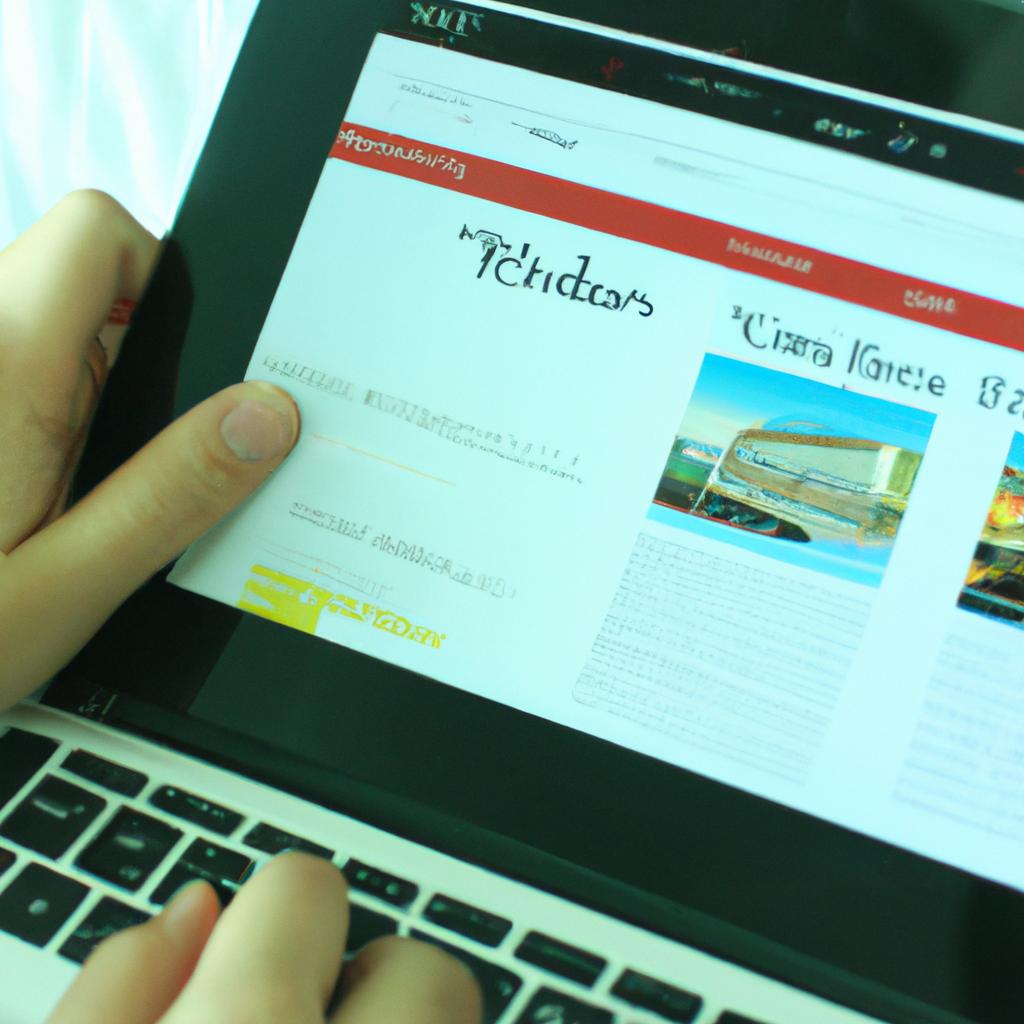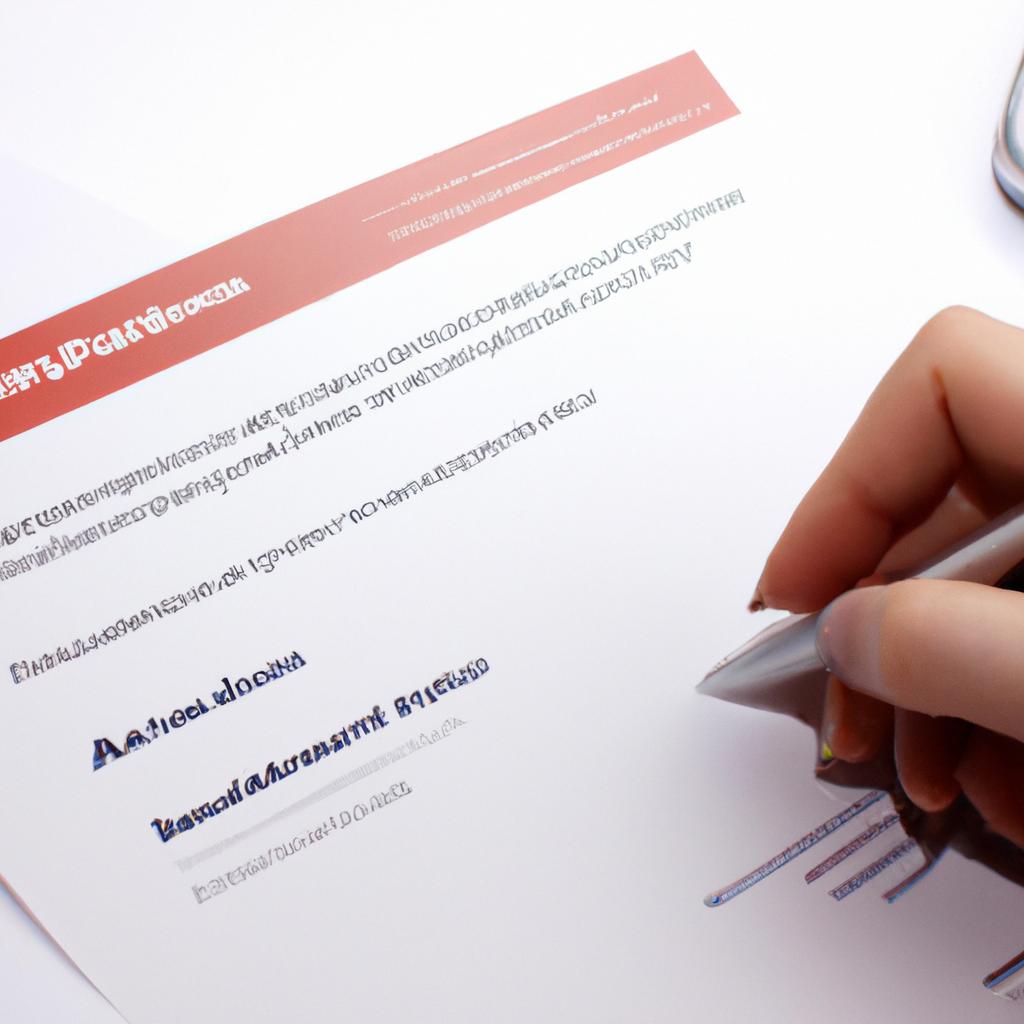In the digital era, hotels have become increasingly reliant on their websites as a primary channel for attracting and converting potential guests. However, simply having an aesthetically pleasing website is no longer enough to drive conversions. To truly optimize conversion rates and maximize revenue, hoteliers must understand and implement effective strategies in both web design and conversion rate optimization (CRO). This article delves into the realm of conversion funnel optimization specifically tailored to hotel web design and CRO.
Consider the following scenario: A luxury boutique hotel situated in a bustling city center recently launched its new website with high hopes of increasing direct bookings. Despite investing considerable time and resources into creating visually appealing pages with captivating content, they found themselves disappointed by lackluster conversion rates. This case study serves as a reminder that achieving optimal results requires more than just aesthetic appeal; it necessitates a comprehensive understanding of how visitors navigate through the various stages of the conversion funnel.
By implementing strategic tactics aimed at enhancing user experience, improving site navigation, refining persuasive messaging, and streamlining booking processes, hotels can significantly increase their chances of converting website visitors into paying customers. Through this article’s exploration of conversion funnel optimization within the context of hotel web design and CRO, readers will gain valuable insights into best practices that can help them drive higher conversion rates and ultimately boost revenue.
One of the key factors in optimizing the conversion funnel for hotel websites is improving user experience. This involves ensuring that the website is easy to navigate, loads quickly, and is mobile-friendly. By providing a seamless browsing experience, hotels can reduce bounce rates and keep visitors engaged on their site for longer periods of time.
Another important aspect of conversion funnel optimization is refining persuasive messaging. Hotels should clearly communicate their unique selling points and value propositions to potential guests. This can be achieved through compelling headlines, persuasive copywriting, and visually appealing imagery that showcases the hotel’s amenities, location, and overall ambiance.
Simplifying the booking process is also crucial for maximizing conversions. Hotels should aim to minimize friction during the booking process by reducing the number of steps required to complete a reservation and eliminating unnecessary form fields. Implementing a user-friendly booking engine with clear calls-to-action can streamline the process and encourage more direct bookings.
Furthermore, personalization plays a significant role in conversion rate optimization for hotel websites. Tailoring content based on visitor preferences or previous interactions can significantly enhance engagement and increase the likelihood of conversions. For example, offering personalized recommendations or showcasing special offers that are relevant to each visitor can create a sense of exclusivity and urgency.
Lastly, implementing analytics tools allows hotels to track user behavior on their website and identify areas for improvement within the conversion funnel. By analyzing data such as click-through rates, bounce rates, and conversion rates at each stage of the funnel, hotels can make data-driven decisions to optimize their website performance continuously.
In conclusion, effective conversion funnel optimization requires a comprehensive understanding of how visitors interact with a hotel’s website at each stage of the funnel. By focusing on enhancing user experience, refining persuasive messaging, simplifying the booking process, personalizing content, and leveraging analytics data, hotels can improve their chances of converting website visitors into paying customers.
Understanding the Conversion Funnel
The conversion funnel is a fundamental concept in digital marketing that outlines the journey users take from their initial interaction with a website to completing a desired action, such as making a purchase or submitting a form. By understanding and optimizing this process, businesses can significantly improve their conversion rates and overall online success.
To illustrate the importance of the conversion funnel, let’s consider an example: Imagine you are running a boutique hotel website. A potential customer lands on your homepage after searching for “luxury hotels in New York City.” At this point, they become aware of your brand and begin their journey through the conversion funnel. They navigate through various pages, explore room options, read guest reviews, and eventually proceed to book a room.
One way to visualize the conversion funnel is through a four-stage model: Awareness, Interest, Decision/Action, and Retention. Each stage represents different user behaviors and intentions along their path towards conversion:
- Awareness: This is where users first encounter your website or brand. It could be through search engine results, social media posts, or online advertisements. Your goal at this stage is to capture attention and pique interest by showcasing attractive visuals and compelling content.
- Interest: Once users are aware of your brand, they enter the interest stage where they actively seek more information about what you offer. In this phase, it’s crucial to provide detailed descriptions of amenities, pricing transparency, and high-quality images that showcase the unique selling points of your hotel.
- Decision/Action: Users who have shown interest now need clear incentives to make a decision or take action (such as booking). Here you should emphasize special offers or promotions like discounted rates or exclusive perks available only when booking directly on your website.
- Retention: After successfully converting visitors into customers, it’s important to maintain engagement with them to increase loyalty and encourage repeat bookings in the future. This can be achieved through personalized email campaigns, loyalty programs, or providing exceptional customer service.
To summarize, understanding the conversion funnel is essential for optimizing website design and increasing conversion rates. By strategically guiding users through each stage of the funnel, businesses can effectively capture attention, generate interest, facilitate decision-making, and nurture long-term relationships with customers.
Key Elements of Hotel Web Design
Imagine a hotel website that attracts thousands of visitors each month, but fails to convert them into paying guests. The conversion funnel plays a crucial role in understanding how users interact with a website and taking steps towards optimizing it for higher conversions. By analyzing this process, we can identify potential areas of improvement in hotel web design.
One real-life example is the case study of Hotel X, which experienced low conversion rates despite having high traffic on their website. Upon closer examination, it was revealed that the hotel’s web design lacked clear call-to-action buttons and had a cluttered layout. This resulted in visitors being unsure about how to proceed or where to find relevant information, leading to frustration and ultimately abandonment of the booking process.
To optimize hotel web designs for higher conversions, consider the following key elements:
- Intuitive Navigation: A well-designed navigation menu ensures easy access to important sections such as room types, amenities, pricing, and contact information. Users should be able to browse effortlessly without feeling overwhelmed or lost.
- Compelling Visuals: High-quality images showcasing the hotel’s rooms, facilities, and surroundings create an emotional connection with potential guests. Utilize professional photography and leverage visual storytelling techniques to captivate your audience.
- Persuasive Copywriting: Well-crafted copy helps convey your unique selling propositions (USPs) effectively. Highlighting special offers or emphasizing benefits like free Wi-Fi or complimentary breakfast can entice users to take action.
- Trust Signals: Building trust is crucial when it comes to online bookings. Incorporate trust signals such as customer reviews, security badges, awards won by the hotel, or partnerships with reputable brands to instill confidence in potential guests.
| Key Elements | Examples |
|---|---|
| Intuitive Navigation | Clear menus with dropdown options |
| Compelling Visuals | Stunning photos of luxurious rooms |
| Persuasive Copywriting | Catchy headlines and compelling descriptions |
| Trust Signals | Testimonials from satisfied guests |
Understanding the conversion funnel and its impact on hotel web design is essential for optimizing websites to drive conversions. By implementing intuitive navigation, compelling visuals, persuasive copywriting, and trust signals, hotels can improve user experience and increase the likelihood of turning website visitors into paying guests.
Transitioning into the subsequent section about “Optimizing Landing Pages for Higher Conversions,” we delve deeper into specific strategies that can further enhance a hotel’s ability to convert potential customers effectively.
Optimizing Landing Pages for Higher Conversions
To further enhance the conversion rates of hotel websites, it is crucial to focus on optimizing landing pages. A well-designed landing page can effectively capture visitors’ attention and guide them towards taking desired actions. Let’s consider a hypothetical example: a luxury boutique hotel aiming to increase direct bookings through its website. By implementing specific strategies, such as clear call-to-action buttons and persuasive content, this hotel could significantly improve its conversion rate.
One key element in optimizing landing pages is ensuring a seamless user experience. Visitors should be able to easily navigate through the page, find relevant information, and complete desired actions without any confusion or frustration. To achieve this, here are some important considerations:
- Clear and concise messaging: Craft compelling headlines and subheadings that clearly communicate the unique value proposition of the hotel. Emphasize benefits rather than features to engage potential guests emotionally.
- Well-placed call-to-action (CTA) buttons: Position CTAs strategically throughout the page to guide users towards conversions. Use contrasting colors and persuasive language to make these buttons stand out and encourage action.
- Mobile optimization: With an increasing number of people accessing websites through mobile devices, it is essential to ensure landing pages are fully responsive and optimized for different screen sizes. This will provide a seamless experience across all devices.
- Trust signals: Incorporate trust elements such as customer testimonials, reviews from reputable sources, security badges, or social proof indicators like follower count on social media platforms. These help build credibility and alleviate any concerns potential guests may have.
Creating an engaging visual layout also plays a significant role in driving conversions on landing pages. Consider using enticing imagery or videos that showcase the unique aspects of your hotel. Additionally, incorporating emotional triggers into your design can evoke positive feelings among visitors and motivate them to take action.
Incorporating bullet point lists can be an effective way to highlight key features or benefits of your hotel. For example:
- Luxurious accommodations with breathtaking views
- Award-winning dining options featuring local and international cuisine
- Relaxing spa treatments to rejuvenate your mind and body
- Convenient location near popular attractions and transportation hubs
Furthermore, a table can be used to compare different room types or packages available at the hotel, helping potential guests make informed decisions based on their preferences.
In summary, optimizing landing pages is crucial for increasing conversion rates on hotel websites. By ensuring a seamless user experience, utilizing persuasive content and design elements, as well as incorporating emotional triggers like bullet point lists and tables, hotels can effectively engage visitors and encourage them to convert. The next section will explore another important aspect of driving conversions: Increasing Conversion Rates through Persuasive Copywriting.
Increasing Conversion Rates through Persuasive Copywriting
Transitioning from the previous section on optimizing landing pages, let us now delve into another crucial aspect of conversion rate optimization (CRO) – enhancing user experience. By creating a seamless and intuitive journey for website visitors, hotels can significantly improve their chances of achieving higher conversion rates. To illustrate this concept, consider the following hypothetical scenario:
Imagine a potential guest visiting a hotel’s website to book a room for an upcoming trip. Upon arriving at the homepage, they are immediately greeted with an aesthetically pleasing design that is visually appealing and aligns with the hotel’s branding. The navigation menu is clear and concise, allowing them to easily explore various sections of the website.
To further enhance user experience and increase conversions, several strategies can be implemented:
- Streamlined Booking Process: Simplifying the booking process by reducing unnecessary steps or form fields can minimize friction and encourage users to complete their reservations.
- Mobile Optimization: Ensuring that the website is fully responsive and optimized for mobile devices allows guests to browse seamlessly across different platforms, increasing accessibility and convenience.
- Engaging Visual Content: Incorporating high-quality images, videos, or virtual tours showcasing the hotel’s amenities and rooms can captivate visitors’ attention and stimulate their desire to make a reservation.
- Personalization: Tailoring content based on user preferences such as language selection or offering personalized recommendations can create a more personalized experience, fostering engagement and trust.
Table 1 below summarizes these user experience enhancement strategies along with their corresponding benefits:
| Strategy | Benefits |
|---|---|
| Streamlined Booking Process | Minimizes friction |
| Mobile Optimization | Increases accessibility |
| Engaging Visual Content | Stimulates desire |
| Personalization | Creates personalized experience |
Incorporating these techniques not only improves user satisfaction but also increases conversion rates. By providing an exceptional user experience, hotels can establish trust and credibility with potential guests, encouraging them to choose their property for their next stay.
Transitioning into the subsequent section on effective use of call-to-actions (CTAs), let us now explore how strategically placed prompts can further optimize conversion rates.
Effective Use of Call-to-Actions (CTAs)
In the pursuit of optimizing conversion rates on hotel websites, an essential aspect to consider is the effective use of call-to-actions (CTAs). CTAs serve as prompts for users to take desired actions and play a crucial role in guiding visitors through the conversion funnel. By strategically implementing persuasive and well-designed CTAs, hotels can significantly enhance their website’s performance in terms of conversions.
One real-life example that exemplifies the impact of optimized CTAs is a case study conducted by Hotel X. The hotel revamped its website by incorporating compelling CTAs throughout various stages of the customer journey. As a result, there was a notable increase in bookings, with conversion rates rising by 20% within three months.
To further emphasize the significance of using effective CTAs, let us explore four key reasons why they are instrumental in driving conversions:
- Clear Communication: Well-crafted CTAs provide clear instructions and communicate precisely what action users need to take next.
- Visual Appeal: Eye-catching design elements such as contrasting colors, enticing graphics, or animations can capture users’ attention and make them more likely to click on CTAs.
- Placement Optimization: Strategic placement of CTAs at prominent locations on web pages ensures maximum visibility and increases the chances of user engagement.
- Compelling Language: Persuasive copywriting techniques combined with emotionally appealing language can evoke a sense of urgency or desire, motivating users to complete desired actions.
Consider this table showcasing different types of CTAs used by successful hotel websites:
| CTA Type | Description | Emotional Impact |
|---|---|---|
| “Book Now” Button | Urges immediate reservation | Creates excitement |
| “Limited Time Offer” Banner | Highlights exclusive deals | Generates anticipation |
| “Subscribe for Exclusive Discounts” Form | Encourages long-term customer engagement | Fosters a sense of exclusivity |
| “Chat with an Expert” Popup | Offers personalized assistance | Builds trust and confidence |
In conclusion, the effective use of CTAs is vital for optimizing conversion rates on hotel websites. By implementing clear communication, visually appealing designs, strategic placement, and compelling language in their CTAs, hotels can guide users towards desired actions. The impact of optimized CTAs has been demonstrated through real-life examples such as Hotel X’s case study.
Transitioning seamlessly into the subsequent section about “Testing and Analyzing Performance Metrics,” understanding how different elements affect website conversions requires careful examination and analysis.
Testing and Analyzing Performance Metrics
Transitioning from the previous section on effective use of call-to-actions (CTAs), we now delve into the importance of testing and analyzing performance metrics to optimize conversion rates in hotel web design. To illustrate this, let us consider a hypothetical scenario where a luxury hotel aims to increase its online bookings through their website.
Testing and analyzing performance metrics is crucial for understanding user behavior and identifying areas for improvement. By conducting A/B tests, heat mapping analysis, and tracking key performance indicators (KPIs), hotels can make data-driven decisions to enhance the overall user experience and maximize conversions.
One example of testing could involve comparing two different layouts for the hotel’s booking page: one with a traditional form layout asking for personal details first, and another with a simplified process that only requires selecting dates and room preferences before prompting users to enter their information. Through A/B testing, it may be discovered that the simplified layout outperforms the traditional one by reducing friction and increasing completion rates.
To further emphasize the significance of testing and analyzing performance metrics, consider the following bullet points:
- Testing allows for optimization based on objective evidence rather than assumptions.
- Analyzing KPIs helps identify bottlenecks or drop-off points within the conversion funnel.
- Heat mapping analysis provides invaluable insights into how users interact with specific elements on a webpage.
- Regular monitoring of performance metrics ensures ongoing improvements are made over time.
In order to provide a visual representation of these concepts, here is an illustrative table showcasing potential KPIs related to conversion rate optimization:
| Metric | Description |
|---|---|
| Conversion Rate | The percentage of visitors who complete a desired action |
| Bounce Rate | The percentage of visitors who leave after viewing only one page |
| Average Session Duration | The average amount of time spent on the website per session |
| Exit Rate | The percentage of visitors who leave after viewing a specific page |
In summary, testing and analyzing performance metrics are essential components of conversion rate optimization in hotel web design. By utilizing A/B testing, heat mapping analysis, and tracking KPIs, hotels can make informed decisions to improve user experience and increase conversions. Through continuous monitoring and refinement, these strategies enable hotels to maximize their online bookings and achieve their business objectives.




